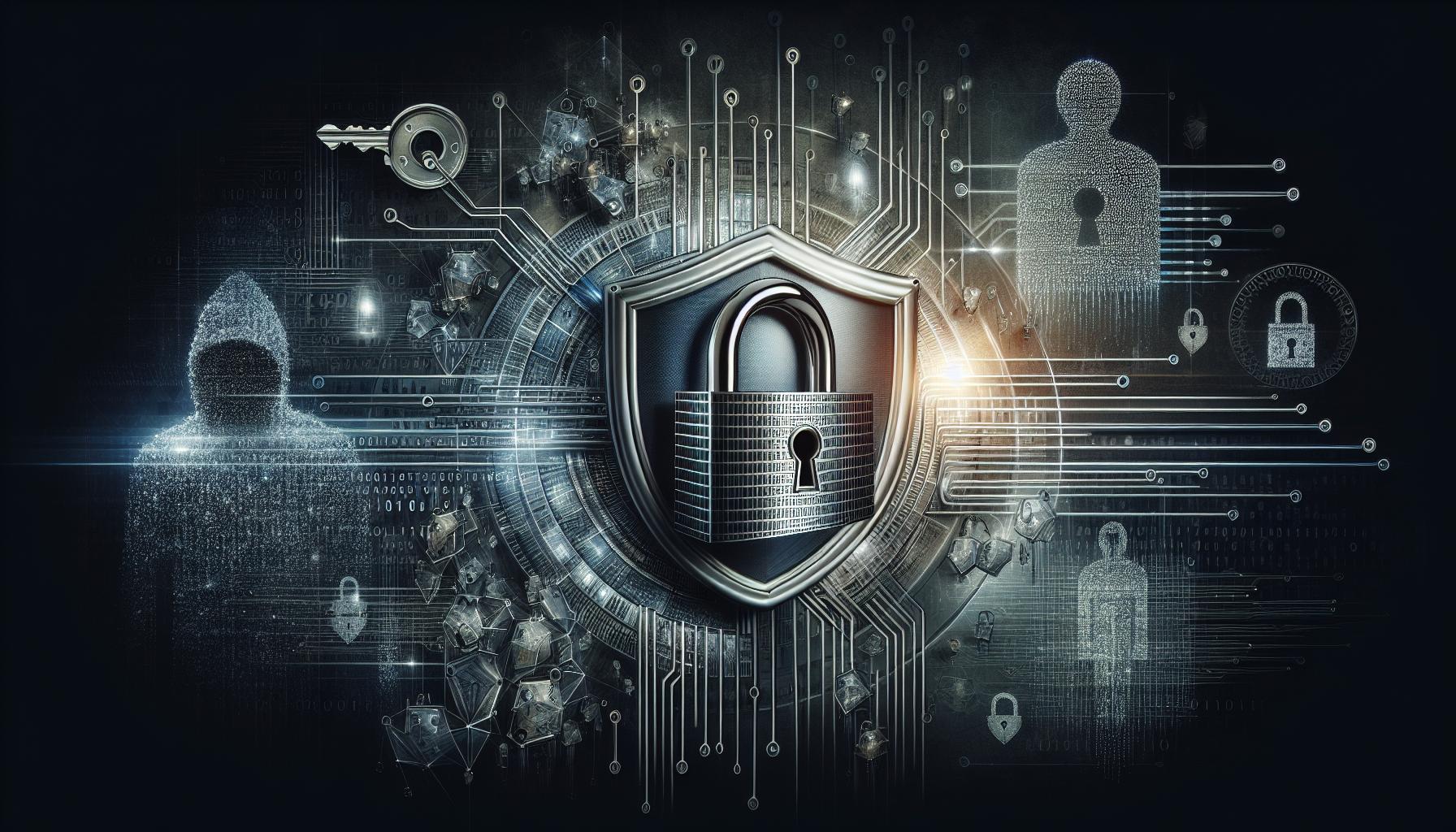Do you ever wonder what do hackers do in their free time? When we hear the term “hacker,” it often conjures up images of shadowy figures typing away in dark rooms, but what do hackers actually do? They’re not just plot points in thrillers; they’re real people with a diverse set of skills.
Hackers navigate the digital landscape, probing for vulnerabilities in networks and systems. Some wear white hats, using their abilities to improve security, while others may cross the line into illegal activities. We’re here to demystify their world and explore the various hats hackers wear in the digital age.
Their activities range from ethical hacking to prevent cyber threats to exploiting weaknesses for personal gain. Let’s dive into the complex, often misunderstood realm of hacking to understand their motives, methods, and the impact they have on our digital security.
Who are hackers?
Understanding who hackers are is crucial to demystifying the talents and techniques behind their screen personas. It’s easy to conjure up an image of a shadowy figure behind a computer screen, but the truth is far more nuanced. Hackers come from diverse backgrounds and possess a wide range of motivations and skill sets. Their expertise extends from coding and programming to an in-depth understanding of security systems.
At the core, hackers are individuals who enjoy the intellectual challenge of creatively overcoming limitations. They often possess an advanced understanding of computer systems and networks, and their activities can either bolster or breach digital security, depending on their intentions.
White-hat hackers, often called ethical hackers, are the good guys. They use their skills to find weaknesses in systems with the goal of fixing them to prevent data breaches and other types of cyber threats. Many are certified professionals who work within the legal confines to secure the digital landscape for businesses and individuals alike.
On the flip side, there are black-hat hackers. These are individuals who exploit vulnerabilities for malicious reasons, which can include theft, espionage, or personal gain. They’re the ones behind the scenes of many high-profile data breaches and security incidents. Then there’s a third category: gray-hat hackers, who might violate ethical standards or laws but without the malicious intent often ascribed to black-hats.
Some key traits synonymous with hackers include:
- Curiosity about how things work
- Persistence in facing complex challenges
- Creative thinking to find unconventional solutions
- Deep technical knowledge of computer systems and networks
The motives behind hacking can range from activism, known as hacktivism, where hacking is used as a form of political or social protest, to the sheer thrill of bypassing a system’s defenses. Knowing who hackers are and why they do what they do helps us not only to appreciate the role they play in cybersecurity but also to understand the various shades within the hacking community.
Different types of hackers
Hackers are often categorized by the hats they metaphorically wear, signaling their intent and legitimacy within the cybersecurity realm. There’s a spectrum of hacker types; some work within the confines of the law while others operate outside of it.
White-Hat Hackers, also known as ethical hackers, serve as the cybersecurity defenders. They’re the good guys in the digital space, striving to protect systems and networks from vulnerabilities by identifying and fixing them before malicious attackers can exploit them. Many of these professionals are certified and work in close alignment with organizations to strengthen their security posture.
On the opposite side are Black-Hat Hackers, the culprits behind data breaches, identity theft, and other cybercrimes. They exploit system weaknesses for personal gain or to inflict harm. Their activities are strictly illegal and they’re often motivated by financial gain, political agendas, or simply the desire for chaos.
Nestled between these extremes are Gray-Hat Hackers, who often fall into a morally ambiguous zone. They may not have the malicious intent of black hats, yet they don’t always seek permission before breaking into systems. Their actions can sometimes result in a positive outcome, such as uncovering a security flaw. However, the legality of their methods is typically questionable.
The hacking community also includes Script Kiddies and Hacktivists. Script Kiddies might lack the technical expertise of other hacker types but can still pose a threat by using existing tools to launch attacks. Hacktivists use their skills to promote political causes, drawing attention to their social or political messages through high-profile hacks.
Understanding the nuances among hacker types is essential for organizations to tailor their cybersecurity strategies effectively. By recognizing the varying motivations and methods, we can better prepare our defenses against the array of threats posed by these diverse groups.
At the core of the hacking ecosystem is a shared set of characteristics that transcends their ‘hat’ designation. Regardless of their intent, most hackers demonstrate a profound understanding of network and system vulnerabilities, innovation in the face of obstacles, and a persistent drive to surpass limitations.
By staying informed about the activities and evolution of different types of hackers, we ensure our vigilance in an increasingly connected world where the battle between cyber defense and offense continues relentlessly.
Ethical hacking and security improvement

Ethical hacking plays a crucial role in bolstering cybersecurity measures. We often hear about malicious cyber attacks, but it’s the ethical hackers who work tirelessly behind the scenes to prevent these incidents. By simulating potential attacks, ethical hackers help organizations identify and fix security flaws before they can be exploited by malicious parties.
We’ve observed that companies across various sectors now acknowledge the importance of these professionals. Ethical hackers carry out an array of tasks, including but not limited to penetration testing, vulnerability assessments, and security auditing. During penetration testing, they actively attempt to ‘hack’ into systems with the intention of uncovering vulnerabilities. Once found, they report these weaknesses to the organization and may assist in developing strategies to secure the systems.
One of the more well-known standards in ethical hacking is the Certified Ethical Hacker (CEH) designation. This signifies that the individual has been trained to look for weaknesses and vulnerabilities in computer systems and possesses the same skills and knowledge as a malicious hacker, but in a lawful and legitimate manner. The intention here is not to do harm, but to improve the security posture of the organizations that employ them.
It’s worth noting that ethical hackers must stay constantly updated with the latest security trends and cyber threat intelligence. This ongoing education is what equips them with the foresight to implement defensive measures effectively. Companies with a proactive stance on cybersecurity often have an ethical hacker, or even a team of them, at the core of their security strategy, ensuring a robust defense against cyber threats.
Unethical hacking and illegal activities

In contrast to their ethical counterparts, black-hat hackers engage in a variety of actions that compromise data integrity and personal privacy. These individuals often breach systems with the intent to steal, alter, or destroy information. The motivation behind such actions can range from financial gain to pure malice.
Cyber crimes perpetrated by black-hat hackers include identity theft, fraud, and unauthorized access to financial accounts. These malicious endeavors not only cause significant financial losses but also disrupt the lives of victims. For instance, phishing scams, which are deceitful attempts to acquire sensitive information such as usernames, passwords, and credit card details, have become an all-too-common threat.
Another prevalent form of unlawful hacking is the creation and dissemination of malware, including viruses, worms, and trojan horses. These harmful programs can damage devices, lead to data loss, and even create backdoors for future attacks. Ransomware, a type of malware that encrypts a victim’s files and demands a ransom payment for the decryption key, has seen a marked rise in recent years, with attacks on both individuals and organizations.
- Identity Theft
- Financial Fraud
- Phishing Scams
- Malware Dissemination
- Ransomware Attacks
The harm caused by these illegal activities extends beyond the digital realm as well; critical infrastructure like power grids, healthcare systems, and government databases are not immune to these threats. Hackers targeting such infrastructure seek to disrupt operations or even cause physical damage, which highlights the real-world consequences of cyber threats.
To address these illegal practices, law enforcement agencies worldwide have developed specialized cybercrime units. These teams work tirelessly to track down and prosecute cyber criminals. Meanwhile, educating the public about online security practices and utilizing cutting-edge cybersecurity measures remain our best defense against the actions of black-hat hackers. By staying informed and vigilant, we can reduce our vulnerability to these increasingly sophisticated and perilous threats.
Motives behind hacking

While hackers may seem like a monolith to the untrained eye, they actually have a kaleidoscope of reasons fueling their actions. These motives are as varied as the individuals themselves, defining the paths they choose in the digital world.
Financial Gain is perhaps the most straightforward driver. Black-hat hackers, in particular, are lured by the lucrative potential of stealing credit card information, blackmailing businesses via ransomware, or engaging in other forms of cyber fraud. For them, every security gap is a potential payday, and they constantly refine their strategies to sidestep safeguards and exploit vulnerabilities.
On the flip side, there are activists known as hacktivists. Their compass is usually oriented by political or social convictions, and they focus their efforts on targets that represent opposing views or engage in activities they find unjust. They may leak sensitive data to shed light on what they consider corruption or censorship, aiming to sway public opinion or prompt change.
Thrill and Reputation also play a pivotal role. The challenge of breaking into well-fortified systems offers an adrenaline rush and the thrill of achievement. Additionally, in certain circles, successful breaches are badges of honor, elevating a hacker’s status among peers. This social component can be a powerful incentive, pushing hackers to attempt increasingly ambitious hacks.
Lastly, some hackers are driven by pure Curiosity and Knowledge Acquisition. They have no intention of causing harm or reaping profit. Instead, they’re in it for the intellectual challenge and the satisfaction of overcoming complex puzzles. These individuals often become white-hat hackers, putting their skills to use in bolstering cybersecurity defenses and raising awareness about potential risks.
Understanding these motives is crucial for us to anticipate, prepare for, and counteract the myriad threats that hackers pose. By recognizing what drives these skilled individuals, we can better predict their targets and strategies, and tailor our cybersecurity measures to be as robust as possible.
Methods and techniques used by hackers

Diving into the arsenal of a hacker, we’ll find a multitude of methods and techniques at their disposal. Social engineering remains a top tactic, leveraging psychological manipulation to lure individuals into giving up confidential information. This can be as simple as a phishing email aimed to deceive the recipient into handing over their login credentials.
Another prevalent strategy hackers employ is exploiting software vulnerabilities. They meticulously search for flaws within systems and applications, often deploying malware that can take control of a computer, steal data, or even establish a persistent backdoor for future access. Once a vulnerability is discovered, it opens the floodgate for potential unauthorized activities.
Moreover, hackers are famed for their ability to execute brute force attacks, which involve systematically checking all possible passwords or passphrases until the correct one is identified. Although this technique can be time-consuming, it’s surprisingly effective, especially against weak passwords.
Hackers also rely on network attacks, which includes Distributed Denial of Service (DDoS) attacks that overwhelm servers with traffic, rendering them non-operational. In addition, they often utilize packet sniffing to intercept and analyze data packets traveling over networks, seeking sensitive information.
Advanced hackers might use more sophisticated methods like SQL injection, where they insert malicious code into a server that uses SQL, allowing them access to the database. Cross-site scripting (XSS) is another technique that enables hackers to inject malicious scripts into benign and trusted websites.
To combat these techniques, it’s essential we continue to evolve our cybersecurity strategies. By understanding the methods hackers use, we’re better equipped to develop effective defenses and train personnel to recognize and react to potential threats. Awareness is the frontline of cyber defense, and staying informed of hacker methodologies is crucial for keeping our systems secure.
Impact of hackers on digital security

Hackers often leave an indelible mark on the landscape of digital security. Through their actions, they have forced businesses, governments, and individuals to evolve their cybersecurity measures. Data breaches spurred by hacking incidents can lead to substantial economic losses and tarnish reputations irreparably.
When hackers infiltrate systems, they expose the vulnerabilities that exist within our digital infrastructure. It’s this unearthing of flaws that compels organizations to enhance their security protocols. Increments in cyber defense strategies include the implementation of multi-factor authentication, end-to-end encryption, and intrusion detection systems.
- Financial Impact: The cost of a data breach can soar into the millions. Businesses face not only remediation costs but also legal fees, fines, and a loss of customer trust.
- Reputational Damage: Once a hack becomes public knowledge, an organization’s reputation may suffer. This can lead to a loss of business and a decline in investor confidence.
- Operational Disruption: Cyberattacks can cripple an organization’s ability to operate, leading to significant downtime and the disruption of services.
White-hat hackers positively impact digital security by identifying and reporting security gaps, providing valuable insights to improve system defenses. Through penetration testing and ethical hacking, they bolster digital fortresses and fortify them against malicious attacks.
Conversely, black-hat hackers’ activities demonstrate the ever-present need to stay ahead in cybersecurity. It’s a constant game of cat and mouse, with security experts striving to outpace the ingenious methods developed by malicious hackers to circumvent security measures.
Advancements in cybersecurity technology often occur in direct response to hacker innovations. As hackers’ techniques grow more sophisticated, so too must the protective measures we carry out to safeguard sensitive data. The continual adaptation and enhancement of security protocols help ensure that digital safety remains robust in the face of emerging threats.
Conclusion
We’ve peeled back the layers to understand the complex world of hackers. Their actions shape our digital landscape, pressing us to forge stronger shields against cyber threats. It’s clear that hackers will remain a driving force in the evolution of cybersecurity. We must appreciate the white-hat community for their invaluable contributions while staying vigilant against the darker facets of hacking. Let’s continue to foster innovation in our defenses, ensuring a safer future for all in the online arena.
Frequently Asked Questions
Who are hackers and what backgrounds do they come from?
Hackers are individuals who explore and exploit vulnerabilities within computer systems and networks. They can originate from diverse backgrounds, with varying skill levels, motivations, and ethical standards.
What is the difference between white-hat and black-hat hackers?
White-hat hackers use their skills to identify and enhance security systems, whereas black-hat hackers exploit vulnerabilities for malicious purposes such as theft, damage, or disruption.
Who are gray-hat hackers?
Gray-hat hackers operate in a legal and ethical gray area, sometimes violating ethical standards or laws, but without the same malicious intent as black-hat hackers.
What are some common traits of hackers?
Typical hacker traits include curiosity, persistence, creative thinking, and a deep technical understanding of computer systems and networks.
What motivates hackers to hack?
Hackers’ motivations range from financial gain, political activism, thrill-seeking, reputation-building, to simple curiosity about systems and their vulnerabilities.
How do hackers impact digital security?
Hackers can have a significant impact on digital security, often causing economic losses and reputational damage through data breaches. They necessitate enhanced organizational security protocols.
